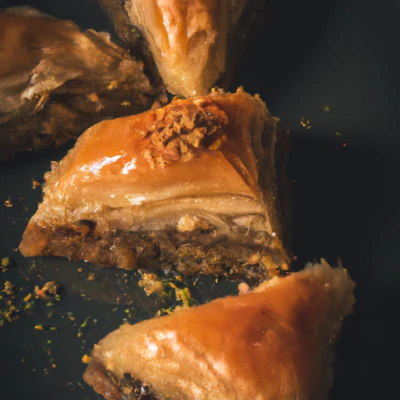Granny's Homemade Baklava

Indulge in the sweet allure of Mediterranean desserts with Granny's Homemade Baklava recipe. This delightful treat is layered with phyllo dough, mixed nuts, and a luscious honey syrup. Granny's recipe brings together the traditional elements of this classic dessert, resulting in a sweet, crunchy, and utterly satisfying treat.
Creating the perfect baklava can seem daunting, but Granny's step-by-step guide makes it a breeze. From preparing the nut mixture to assembling the layers of phyllo and nuts, you'll be a baklava expert in no time.

Ingredients
6 oz shelled pistachios, coarsely chopped 6 oz walnuts, coarsely chopped 6 oz hazelnuts, coarsely chopped ¼ cup sugar 1 to 2 tablespoon ground cinnamon large pinch of ground cloves 16-oz package phyllo dough, thawed 1 ½ to 2 sticks of unsalted butter (up to 16 tbsp), melted ¾ cup sugar 1 cup cold water 1 cup honey 1 tbsp orange extract (optional) 5 whole cloves 1 lemon, juiced
Method
- 1. Start by preheating the oven to 350 degrees F.
- 2. For the honey syrup, combine sugar and water in a saucepan and heat on the stove, stirring occasionally, until the sugar dissolves. Add honey, orange extract (if using), and whole cloves, stirring to mix. Bring the mixture to a boil, then lower the heat and let it simmer for about 25 minutes. Remove the syrup from the heat and let it cool to lukewarm. Add lemon juice and remove the whole cloves.
- 3. To prepare the nut mixture, add the pistachios, walnuts, and hazelnuts to a food processor and pulse a few times to chop. Transfer the chopped nuts to a large mixing bowl and add sugar, cinnamon, and ground cloves. Mix well to combine.
- 4. Unroll the thawed phyllo pastry and place the sheets between two clean kitchen towels. This will help keep the phyllo from breaking while you work.
- 5. Prepare a 9”x 13”x 2” baking pan. Brush the interior of the baking pan with some of the melted butter. To assemble the baklava, place one sheet of phyllo in the pan and brush the top of the phyllo sheet with the melted butter. Repeat this process until you have used up about ⅓ of the phyllo pastry, brushing each layer with the melted butter. Now, distribute about ½ of the nut mixture evenly over the top layer of phyllo. Continue assembling the baklava, one sheet of phyllo pastry at a time using another ⅓ of the phyllo. Again, brush each layer with a bit of the melted butter. Distribute the remaining ½ of the nut mixture evenly over the top layer of phyllo. Finish the remaining ⅓ of the phyllo pastry following the same process, laying one folded sheet at a time and brushing each layer with melted butter. Brush the very top sheet of phyllo with butter.
- 6. Using a sharp knife, cut the pastry into 24 diamond shaped pieces. Place the baking dish on the middle rack of your heated oven. Bake anywhere from 35 to 45 minutes or until the top of the baklava turns golden and a skewer inserted in the center comes out clean.
- 7. As soon as you remove the baklava from the oven, pour the cooled syrup all over the hot baklava.
- 8. Allow baklava to sit for a few hours before serving or for at least 1 hour. Cut through the earlier marked pieces. Serve with a garnish of chopped pistachios, if you like.

All About Baklava: A Sweet Journey
Take a sweet journey into the heart of Mediterranean desserts with Baklava. This rich, sweet pastry made of layers of phyllo filled with chopped nuts and sweetened with honey is a staple in many Middle Eastern and Balkan cuisines. From its historical origins to its modern-day variations, Baklava is a testament to the universal love for sweet treats.
The History of Baklava
Baklava is a rich, sweet dessert pastry made of layers of filo filled with chopped nuts and sweetened and held together with syrup or honey. It is characteristic of the cuisines of the Levant, the Caucasus, Balkans, Maghreb, and of Central and West Asia. The history of baklava is not well documented; but its current form was probably developed in the imperial kitchens of the Topkapı Palace in Istanbul.
Regional Variations
From Turkey to Greece, and from Lebanon to Iran, Baklava takes on different forms and flavors. In Iran, a drier version of Baklava is cooked and presented in smaller diamond-shaped cuts flavored with rose water. The Greeks' major contribution to the development of this pastry is the creation of a dough technique that made it possible to roll it as thin as a leaf, compared to the rough, bread-like texture of the Assyrian dough. In fact, the name "Phyllo" was coined by Greeks, which means "leaf".
Serving Suggestions
Baklava is a versatile dessert that can be served at the end of a meal or as a sweet snack. It pairs well with a cup of strong coffee or a glass of dessert wine. For a complete Mediterranean experience, consider serving Baklava with other regional favorites like Moussaka, Greek Yogurt or Turkish Tea. And remember, Baklava is best enjoyed fresh, so savor every bite!